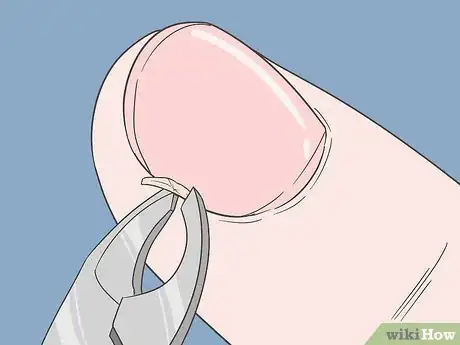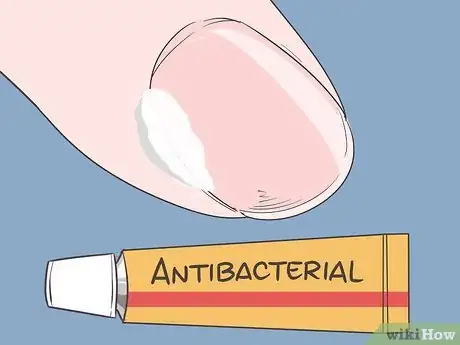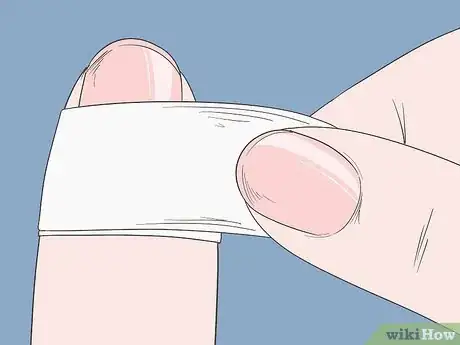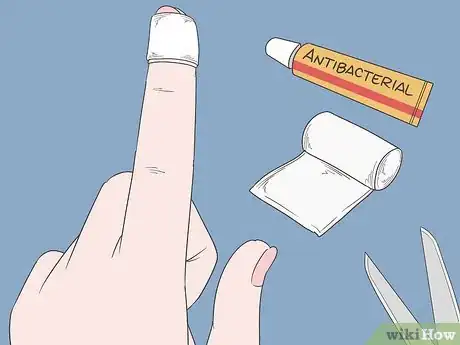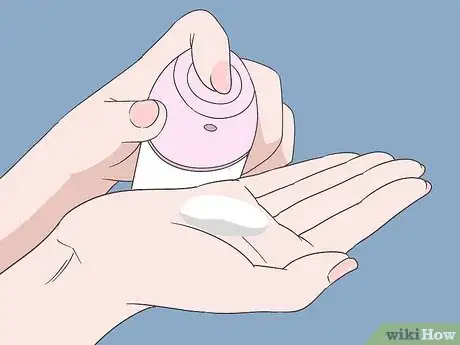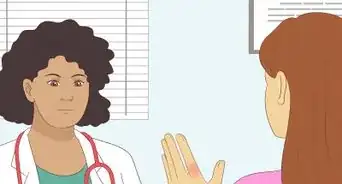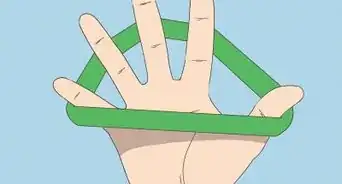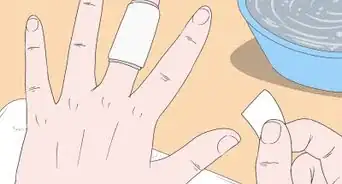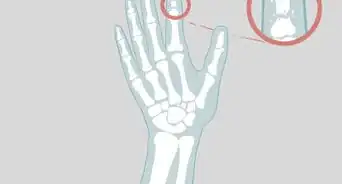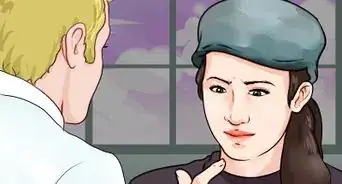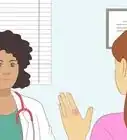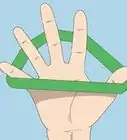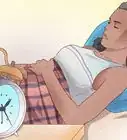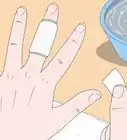This article was co-authored by Mohiba Tareen, MD. Mohiba Tareen is a board certified Dermatologist and the founder of Tareen Dermatology located in Roseville, Maplewood and Faribault, Minnesota. Dr. Tareen completed medical school at the University of Michigan in Ann Arbor, where she was inducted into the prestigious Alpha Omega Alpha honor society. While a dermatology resident at Columbia University in New York City, she won the Conrad Stritzler award of the New York Dermatologic Society and was published in The New England Journal of Medicine. Dr. Tareen then completed a procedural fellowship which focused on dermatologic surgery, laser, and cosmetic dermatology.
This article has been viewed 37,664 times.
Hangnails occur when the skin along the sides of your fingernails and near your cuticles peels up and tears. This is typically caused by dry skin and results in a painful, annoying injury.[1] Luckily, there are some things you can do to take care of your hangnails and help them heal faster. With a few standard nail care and first-aid supplies, your hands should be back to normal in a few days. Make sure to follow standard wound-care guidelines to keep your hangnails clean and prevent an even more painful infection.
Steps
Trimming the Hangnail
-
1Put an adhesive bandage over your hangnail until you can trim it. Wrap a small bandage tightly around your finger on top of the hangnail if you can’t deal with it right away. This will keep it from tearing further until you get home or somewhere where you can take care of it properly.[2]
- If your torn skin is bleeding, apply pressure with a clean, dry paper towel or cloth for about 10 minutes to stop the bleeding before you apply a bandage.
-
2Wash your hands with warm water and soap to clean the affected area. Wet your hands under warm running water, then lather them up thoroughly with soap. Rinse your hands until all the soap is gone.[3]
- A hangnail is just like any other wound, so it’s important to keep it clean to avoid an infection.
- The warm water will also soften up your skin and make the hangnail easier to treat.
Advertisement -
3Dry your hands thoroughly using a clean towel. Your hands must be dry so you can apply ointment and a bandage after you remove your hangnail. Be gentle, so you don’t accidentally tear your hangnail further.
- If you don’t have a clean towel, use paper towels instead or shake your hands off and let them air dry. Don’t ever use a dirty towel that could transfer dirt and bacteria into your torn skin.
-
4Sterilize a pair of cuticle trimmers with rubbing alcohol or another disinfectant. Place the cuticle trimmers in a small container. Pour in enough rubbing alcohol, isopropyl alcohol, or hydrogen peroxide to cover the trimmers, then let them soak for at least 10 seconds. Pull the trimmers out of the liquid and wipe them dry with a clean towel.[4]
- If you don’t have cuticle trimmers, you can use manicure scissors or nail clippers instead.
- If you don’t have some kind of disinfecting liquid, you can wash your cutting utensil in warm water and detergent.
-
5Use clean cuticle trimmers to trim the tough skin near your cuticles. Carefully clip off the loose, rough, dead skin of the hangnail, so it won’t get caught on anything and tear even more. Leave the soft, more sensitive, living skin closest to your nails and cuticles.[5]
- If the hangnail is on your dominant hand and you are having trouble trimming it with your non-dominant hand, you can get someone to help you trim it.
Warning: Never bite or chew off your hangnails. You could transfer bacteria to the tear from your mouth or end up tearing your skin more and making the hangnail worse.
Helping Your Hangnail Heal
-
1Apply an antibacterial ointment to your hangnail. Squeeze a dab of antibacterial ointment onto a clean fingertip. Gently rub it onto the hangnail until it is completely covered.[6]
- The ointment will keep your hangnail moist to help it heal faster, as well as prevent infection while the wound heals.
-
2Cover the hangnail with an adhesive bandage to protect it. Carefully wrap a small adhesive bandage around your finger on top of the hangnail. This will keep it from catching on anything and tearing more while it is healing.[7]
- The bandage will also help keep dirt and bacteria from getting in your torn skin and potentially infecting it or slowing down the healing process.
-
3Reapply ointment and replace the bandage daily until your hangnail heals. Gently remove the bandage and wash your hands in warm, soapy water to clean your hangnail, then dry them with a clean towel. Cover the hangnail in fresh ointment and wrap a new adhesive bandage around it.[8]
- As long as you take care of your hangnail like this every day, it should heal in about 5-7 days.
Warning: If your hangnail doesn’t appear to be healing after about 1 week, or it is inflamed or seems to be getting worse, visit a doctor to get it checked out.[9]
-
4Moisturize your hands 2-3 times a day to avoid future hangnails.[10] Apply a non-perfumed lotion to your hands after each time you wash them or a couple of times throughout the day to keep your cuticles from drying out. Put 1 drop of cuticle oil onto each finger where the cuticle meets the nail before you go to bed to keep the skin hydrated throughout the night.[11]
- Since hangnails are caused by dry skin, if you keep your skin moist after your hangnail heals, it will decrease the chances of it happening again.[12]
Expert Q&A
-
QuestionIs it safe to wear nail polish all the time?
 Mohiba Tareen, MDMohiba Tareen is a board certified Dermatologist and the founder of Tareen Dermatology located in Roseville, Maplewood and Faribault, Minnesota. Dr. Tareen completed medical school at the University of Michigan in Ann Arbor, where she was inducted into the prestigious Alpha Omega Alpha honor society. While a dermatology resident at Columbia University in New York City, she won the Conrad Stritzler award of the New York Dermatologic Society and was published in The New England Journal of Medicine. Dr. Tareen then completed a procedural fellowship which focused on dermatologic surgery, laser, and cosmetic dermatology.
Mohiba Tareen, MDMohiba Tareen is a board certified Dermatologist and the founder of Tareen Dermatology located in Roseville, Maplewood and Faribault, Minnesota. Dr. Tareen completed medical school at the University of Michigan in Ann Arbor, where she was inducted into the prestigious Alpha Omega Alpha honor society. While a dermatology resident at Columbia University in New York City, she won the Conrad Stritzler award of the New York Dermatologic Society and was published in The New England Journal of Medicine. Dr. Tareen then completed a procedural fellowship which focused on dermatologic surgery, laser, and cosmetic dermatology.
FAAD Board Certified Dermatologist It's best to take a break from nail polish sometimes. Both nail polish and nail polish remover contain harsh chemicals that could damage your nails or dry them out.
It's best to take a break from nail polish sometimes. Both nail polish and nail polish remover contain harsh chemicals that could damage your nails or dry them out. -
QuestionWhat causes hangnails?
 Mohiba Tareen, MDMohiba Tareen is a board certified Dermatologist and the founder of Tareen Dermatology located in Roseville, Maplewood and Faribault, Minnesota. Dr. Tareen completed medical school at the University of Michigan in Ann Arbor, where she was inducted into the prestigious Alpha Omega Alpha honor society. While a dermatology resident at Columbia University in New York City, she won the Conrad Stritzler award of the New York Dermatologic Society and was published in The New England Journal of Medicine. Dr. Tareen then completed a procedural fellowship which focused on dermatologic surgery, laser, and cosmetic dermatology.
Mohiba Tareen, MDMohiba Tareen is a board certified Dermatologist and the founder of Tareen Dermatology located in Roseville, Maplewood and Faribault, Minnesota. Dr. Tareen completed medical school at the University of Michigan in Ann Arbor, where she was inducted into the prestigious Alpha Omega Alpha honor society. While a dermatology resident at Columbia University in New York City, she won the Conrad Stritzler award of the New York Dermatologic Society and was published in The New England Journal of Medicine. Dr. Tareen then completed a procedural fellowship which focused on dermatologic surgery, laser, and cosmetic dermatology.
FAAD Board Certified Dermatologist Hangnails are typically caused by dry skin. Keeping your skin moisturized may help you prevent hangnails in the future, so apply lotion or hand cream to your hands and nails 2 to 3 times a day.
Hangnails are typically caused by dry skin. Keeping your skin moisturized may help you prevent hangnails in the future, so apply lotion or hand cream to your hands and nails 2 to 3 times a day.
Warnings
- Seek medical assistance if the skin around your nail bed is torn or cut deeply or if your hangnail doesn’t heal after about a week.⧼thumbs_response⧽
- Don’t chew or bite your hangnails to remove them. You could cause an infection or tear your skin even more.⧼thumbs_response⧽
- Watch out for an infected hangnail.⧼thumbs_response⧽
Things You’ll Need
- Water
- Soap
- Towel
- Cuticle trimmers
- Adhesive bandages
- Antibacterial ointment
- Moisturizer
- Cuticle oil
References
- ↑ Mohiba Tareen, MD. FAAD Board Certified Dermatologist. Expert Interview. 26 March 2020.
- ↑ https://healthfully.com/how-to-heal-torn-skin-on-your-fingers-8141327.html
- ↑ https://www.aad.org/public/parents-kids/healthy-habits/parents/kids/hangnails
- ↑ https://ww2.health.wa.gov.au/Articles/F_I/Guide-to-cleaning-and-disinfecting-equipment-for-the-body-art-beauty-and-nail-industries
- ↑ https://www.gq.com/story/how-to-heal-hangnails
- ↑ https://www.aad.org/public/parents-kids/healthy-habits/parents/kids/hangnails
- ↑ https://www.aad.org/public/parents-kids/healthy-habits/parents/kids/hangnails
- ↑ https://healthfully.com/how-to-heal-torn-skin-on-your-fingers-8141327.html
- ↑ https://www.aad.org/public/parents-kids/healthy-habits/parents/kids/hangnails
- ↑ Mohiba Tareen, MD. FAAD Board Certified Dermatologist. Expert Interview. 26 March 2020.
- ↑ https://healthfully.com/how-to-heal-torn-skin-on-your-fingers-8141327.html
- ↑ Mohiba Tareen, MD. FAAD Board Certified Dermatologist. Expert Interview. 26 March 2020.
- ↑ Mohiba Tareen, MD. FAAD Board Certified Dermatologist. Expert Interview. 26 March 2020.



